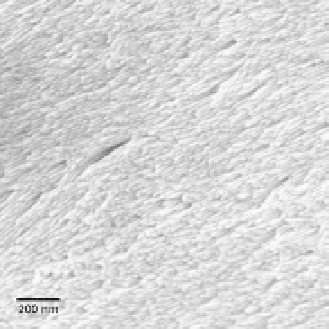Biomedical Engineering Reference
In-Depth Information
(a)
(b)
Figure 2.13
Effect of template degradation processing on Pt nanowire
stability (SEM micrographs). (a) Removal by rinsing in organic solvent and
drying can lead to complete collapse of the nanowire array. (b) Dry etching
by UV-ozone or O
2
plasma etching leaves the wires standing. Viewing
°
angle 45
.
Removal of the polymer matrix in Fig. 2.12b was achieved by UV-
ozone etching after electrochemical deposition. At such high aspect
ratios (diameter 12 nm, length 800 nm) the wires are somewhat
unstable even after dry etch processing. A much greater stability
problem is encountered when the array is exposed to processing
with a liquid phase. Fig. 2.13 shows how rinsing away the polymer
template in organic solvent and simply allowing the film to dry leads
to extensive collapse of the array, most likely caused by capillary
forces in the liquid solvent during drying.
2.4.4.3 Polymeric nanowire replicaion
The great attraction of electrochemical deposition as a means of
BCP replication is the broad range of potential filling materials. Russell
et al.
demonstrated deposition of conducting polypyrrole (PPy)
nanowires into the pores of a 100 nm thick PS-
-PMMA template
on ITO glass using lithium perchlorate in propylene carbonate as
a supporting electrolyte [79]. The template was vertically aligned
on a polymer brush neutralized substrate by the addition of low
molecular weight PMMA homopolymer (Section 2.3.1). Open pores
b










Search WWH ::

Custom Search